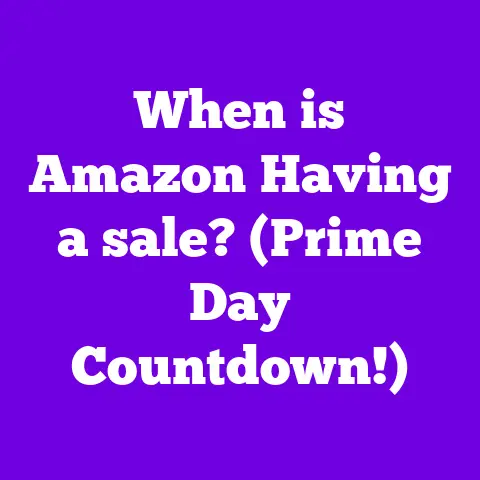When Do Xmas Trees Go On sale? (Before They’re *Gone!*)
It’s a scene I’ve witnessed countless times – the frantic rush of families in late December, desperately searching for that perfect Christmas tree.
Last year, I watched a young couple, their faces etched with disappointment, navigate a barren Christmas tree lot, the few remaining trees looking sparse and forlorn.
They had waited too long, and the pickings were slim.
The dream of a lush, fragrant centerpiece for their holiday celebrations was fading fast.
The holiday season, while filled with joy and anticipation, can also be incredibly stressful.
Between gift shopping, meal planning, and coordinating family gatherings, the pressure to create the “perfect” Christmas can be overwhelming.
And right in the middle of it all is the quest for the ideal Christmas tree – the symbol of the season.
So, when is the best time to buy a Christmas tree?
When can you secure that beautiful, fragrant centerpiece without battling crowds or settling for a Charlie Brown tree?
That’s the question I’m here to answer, providing you with the ultimate guide to Christmas tree shopping for 2025, ensuring you don’t miss out on the best selection and the most magical experience.
Section 1: The Demand and Supply Dynamics of Christmas Trees
The Christmas tree market operates on a highly seasonal cycle.
Demand surges from late November, typically around Thanksgiving and Black Friday, and continues through mid-December, before sharply declining as Christmas approaches.
This concentrated demand puts pressure on supply chains, impacting tree availability and quality.
Several factors influence the supply of Christmas trees.
- Weather Conditions: Extreme weather events, such as droughts, floods, or severe frosts, can significantly damage tree farms, reducing the overall supply.
For example, the Pacific Northwest experienced a severe heatwave in 2021, impacting tree growth and potentially affecting future harvests. - Farming Practices: It takes approximately 7-10 years to grow a Christmas tree to a marketable size.
As such, planting decisions made years ago directly impact the supply available today.
Economic downturns or changes in consumer preferences can lead to over- or under-planting, creating supply imbalances. - Consumer Trends: The popularity of different tree types, the demand for organic or sustainably grown trees, and even the overall economic climate can affect which trees are available and at what price.
Christmas Tree Sales Data:
According to the National Christmas Tree Association (NCTA), approximately 20.8 million real Christmas trees were sold in the U.S.
in 2022.
Source: NCTA 2022 Christmas Tree Sales Survey Summary
Here’s a table showing the trends over the past few years:
Peak buying days typically fall within the first two weeks of December, with weekends being the busiest.
As these days pass, the selection dwindles, and the remaining trees may not be the highest quality.
This is why understanding the timing of sales is crucial.
Section 2: The Best Times to Buy Christmas Trees
Navigating the Christmas tree market requires a strategic approach.
Here’s a breakdown of the ideal times to buy, along with the pros and cons of each period:
Late November (Black Friday to Thanksgiving): This is often the sweet spot for Christmas tree shopping.
Many tree lots and retailers offer Black Friday and Thanksgiving weekend sales, providing significant discounts on trees.
The selection is at its peak, with a wide variety of sizes, types, and grades available.-
Pros: Good selection, festive atmosphere.
- Cons: Higher prices compared to Black Friday sales, potentially larger crowds, risk of lower quality trees as the best ones are already taken.
Mid to Late December (After the Second Week): This is the last-chance window for buying a real Christmas tree.
Retailers often offer significant discounts to clear out remaining inventory.
However, the selection is severely limited, and the remaining trees may be of lower quality or already showing signs of drying out.-
Pros: Potential for deep discounts.
- Cons: Very limited selection, lower quality trees, risk of the tree drying out quickly, may miss out altogether if you wait too long.
Industry Insights:
I spoke with John Miller, owner of “Miller’s Family Tree Farm” in Oregon, who shared his insights: “We see a huge rush right after Thanksgiving.
People are excited to get their trees early and enjoy them throughout the holiday season.
By mid-December, the selection starts to thin out, and we’re mostly selling what’s left.
We do offer discounts towards the end, but the best trees are always gone by then.”
Section 3: Types of Christmas Trees and Their Availability
The type of Christmas tree you choose is a matter of personal preference, but understanding the characteristics of different varieties can help you make an informed decision.
Here are some of the most popular types:
- Fraser Fir: Known for its excellent needle retention, strong branches, and pleasant fragrance.
It’s a popular choice for ornaments and is often considered a premium tree. - Noble Fir: Another excellent choice for needle retention and strong branches.
Its bluish-green needles and open branching make it ideal for displaying ornaments. - Balsam Fir: A classic Christmas tree with a strong, traditional fragrance.
It’s known for its symmetrical shape and soft needles. - Douglas Fir: Widely available and relatively inexpensive.
It has a sweet fragrance and a full, bushy appearance. - Scotch Pine: Known for its excellent needle retention and sturdy branches.
It’s a good option for those who want a tree that will last throughout the holiday season.
The availability of these varieties can vary depending on the region and the time of year.
Fraser Firs and Noble Firs are often in high demand and may sell out quickly, especially in areas where they are not locally grown.
Sustainability:
When choosing a Christmas tree, consider the environmental impact.
Locally grown trees are generally more sustainable than imported ones, as they reduce transportation emissions.
Look for tree farms that practice sustainable forestry, such as replanting trees and minimizing the use of pesticides.
You can also opt for a live, potted Christmas tree that can be replanted after the holidays.
Section 4: The Importance of Buying Early
Purchasing your Christmas tree early offers numerous advantages that contribute to a more enjoyable and stress-free holiday experience.
- Better Selection and Quality: As mentioned earlier, buying early ensures you have access to the widest selection of trees.
You can choose the perfect size, shape, and type to suit your preferences and home décor.
You’ll also have a better chance of finding a tree that is fresh and healthy, with good needle retention. - More Time to Choose: Rushing to buy a tree in mid-December can lead to impulsive decisions and settling for a less-than-ideal tree.
Buying early allows you to take your time, compare different options, and make a thoughtful choice. - Less Stress: The holiday season is already stressful enough.
By getting your Christmas tree early, you can eliminate one major source of anxiety and focus on other aspects of your holiday preparations.
Personal Anecdotes:
I remember one year, I waited until the second week of December to buy my tree.
I ended up settling for a scraggly Douglas Fir that was already shedding needles.
It was a constant source of frustration throughout the holidays.
The next year, I bought my tree the weekend after Thanksgiving, and the difference was remarkable.
I found a beautiful Fraser Fir that filled my home with its fragrance and lasted well into January.
It completely transformed my holiday experience.
- Local Tree Farms: These offer the freshest trees, as they are often cut down just days before being sold.
You can also enjoy the experience of cutting your own tree, creating a memorable family tradition.- Pros: Freshness, unique experience, support local businesses.
- Cons: May be more expensive, limited selection compared to larger retailers.
- Big-Box Retailers (e.g., Home Depot, Lowe’s): These offer convenience and competitive prices.
They typically have a wide selection of trees, but the quality may vary.- Pros: Convenience, competitive prices, wide selection.
- Cons: Trees may not be as fresh, less personal experience.
- Online Options: Some companies offer Christmas trees delivered directly to your door.
This can be a convenient option, but you won’t be able to inspect the tree before buying it.- Pros: Convenience, no need to transport the tree.
- Cons: Cannot inspect the tree before buying, potential for shipping delays or damage.
Notable Local Tree Farms:
In my area, “Pine Ridge Tree Farm” has a fantastic reputation for quality and customer service.
They offer a wide variety of trees, including Fraser Firs, Noble Firs, and Balsam Firs, and they provide helpful advice on tree care.
Section 6: Tips for Choosing the Perfect Christmas Tree
Once you’ve decided when and where to buy your tree, here are some tips for selecting the perfect one:
- Freshness Indicators: Look for a tree with vibrant green needles that are firmly attached to the branches.
Gently pull on a few needles – if they come off easily, the tree may be drying out.
Also, check the trunk for stickiness; a sticky trunk indicates good sap content and freshness. - Size Considerations: Measure the height of your ceiling and the width of the space where you plan to place the tree.
Choose a tree that is slightly shorter than your ceiling height to allow room for the tree topper. - Personal Preferences: Consider the shape and type of tree that you prefer.
Do you want a full, bushy tree or a more open, natural-looking tree?
Do you prefer a strong fragrance or a more subtle scent?
Christmas Tree Checklist:
As you look ahead to the 2025 holiday season, I encourage you to plan your Christmas tree purchase in advance.
Consider visiting a local tree farm in late November or taking advantage of Black Friday sales.
By doing so, you’ll not only get the best selection and quality but also create a more relaxed and enjoyable holiday experience.
The perfect Christmas tree is out there, waiting for you.
But you need to act before it’s gone!






